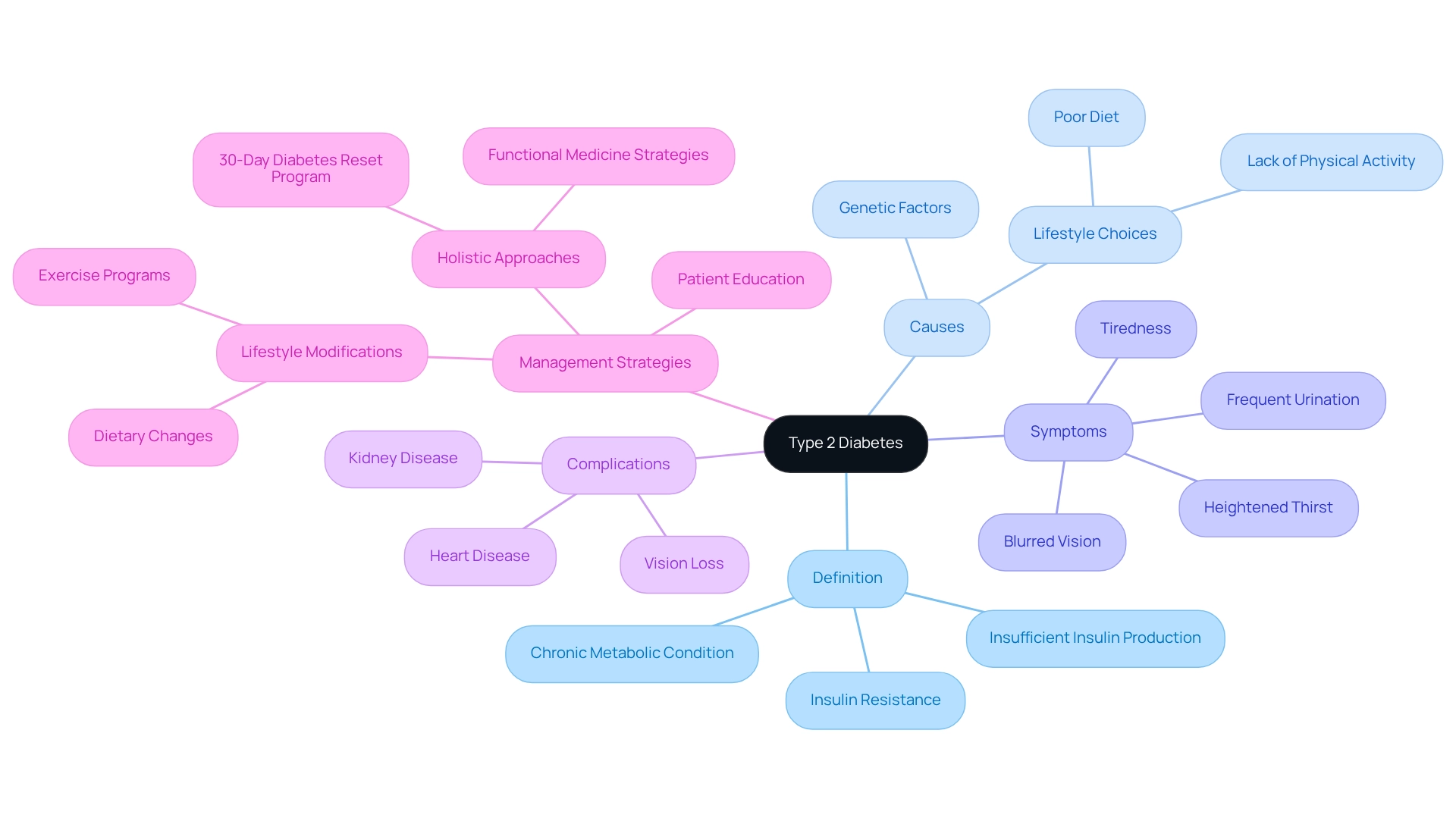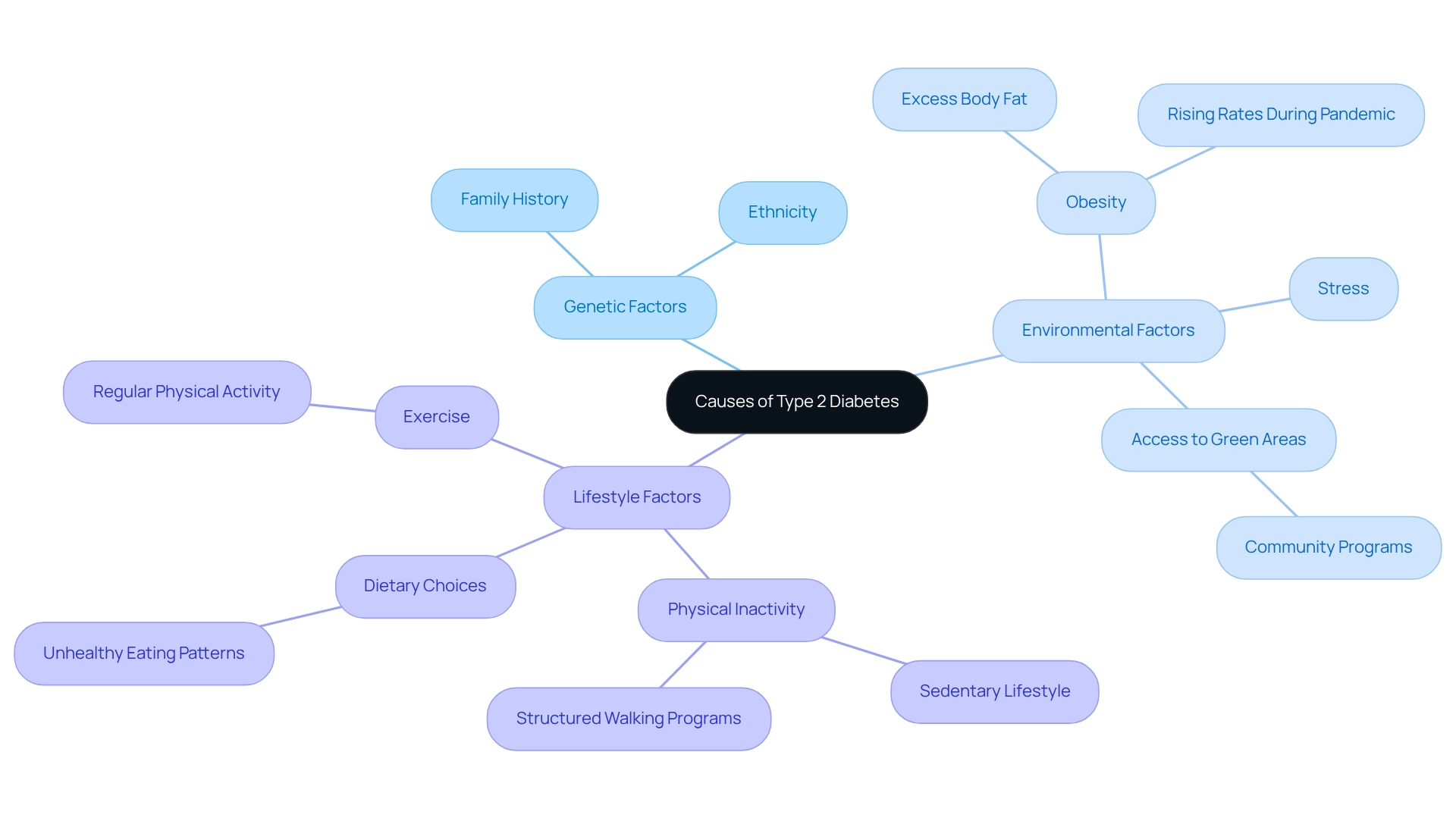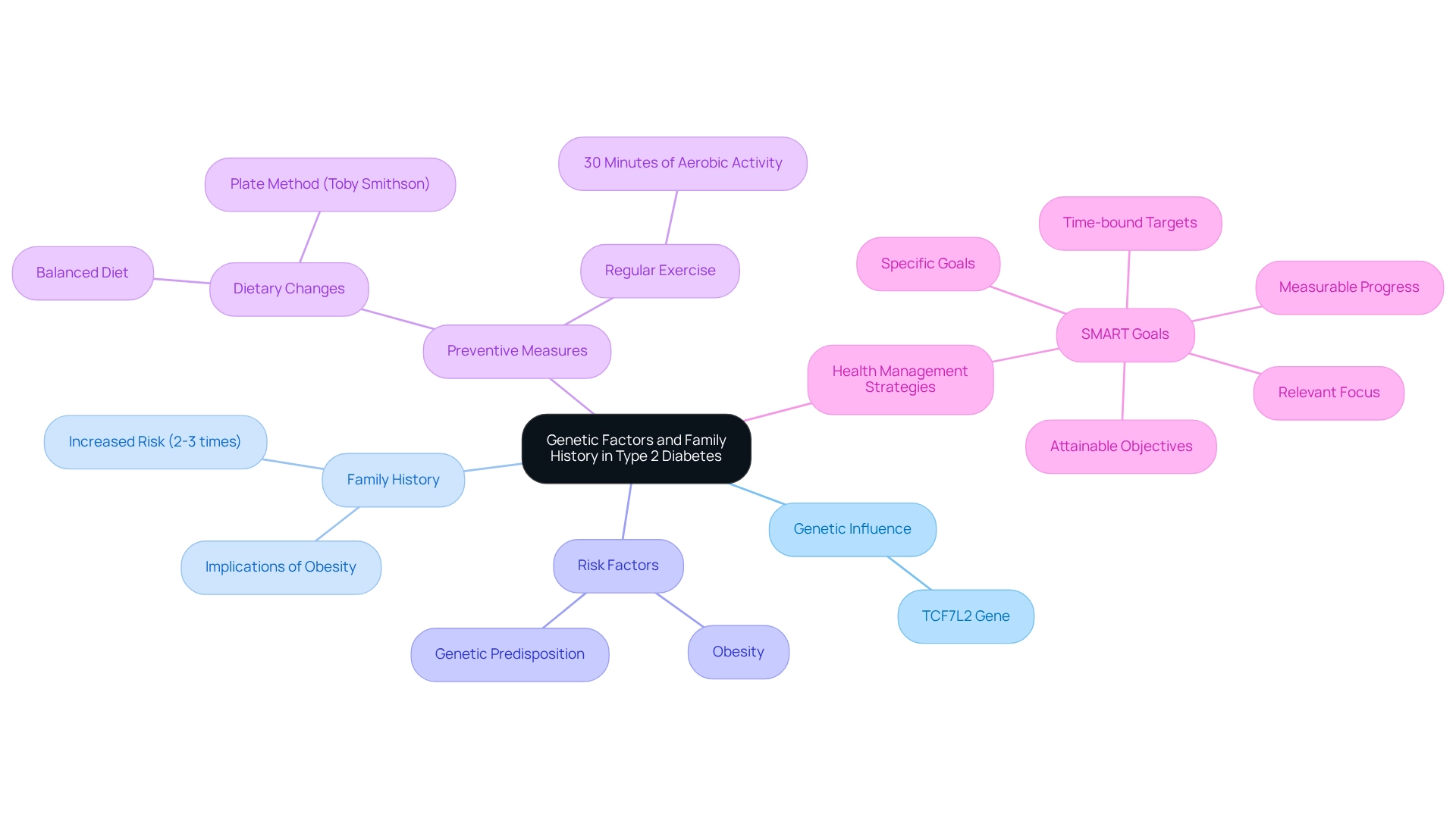Overview
Understanding type 2 diabetes can feel overwhelming, especially when considering the complex interplay of genetic, environmental, and lifestyle factors. It’s important to recognize that obesity and physical inactivity are significant contributors to this condition. By acknowledging these challenges, we can empower ourselves to take proactive steps toward better health.
Many patients find that understanding causes like insulin resistance, which can arise from excess body fat, and the impact of family history can be enlightening. This knowledge can inspire individuals to make meaningful lifestyle changes that lower their risk of developing type 2 diabetes. Remember, you are not alone in this journey, and every small step counts.
As you consider these insights, think about how you can incorporate healthier habits into your daily routine. What changes can you make today that will lead to a healthier tomorrow? Embracing a supportive program, like the 30-Day Diabetes Reset, can provide the guidance and encouragement needed to foster lasting change. Together, we can navigate this path toward a healthier life.
Introduction
In a world where chronic health conditions are increasingly prevalent, understanding type 2 diabetes is more important than ever. This complex metabolic disorder affects millions, yet many individuals may not realize its gradual onset and the serious health risks it brings, such as heart disease and vision loss. It’s concerning to note that a significant portion of the population is living with prediabetes, often without awareness. This highlights the urgent need for increased awareness and intervention.
It’s important to recognize that beyond the medical implications, exploring the genetic, environmental, and lifestyle factors presents a multifaceted view of this condition. Many people find that by delving into the causes, symptoms, and management strategies, they can take proactive steps toward reclaiming their health. Together, we can mitigate the risks associated with type 2 diabetes and foster a healthier future.
Define Type 2 Diabetes: Understanding the Condition
Type 2 diabetes mellitus is a chronic metabolic condition that can feel overwhelming, leading many to wonder what causes type 2 diabetes?, characterized by elevated blood sugar levels due to insulin resistance and insufficient insulin production. Unlike type 1 diabetes, where the body cannot produce insulin at all, individuals with type 2 can still produce insulin; however, their cells may not respond effectively to it. This condition often develops gradually, frequently going unnoticed for years. It’s crucial to address it, as it can lead to severe health complications, including heart disease, vision loss, and kidney disease. Current statistics reveal that eight in ten Americans with prediabetes are unaware of their condition, highlighting the critical need for awareness and early intervention. Furthermore, with more than 7,000 erroneous medications administered to individuals in medical facilities and 80,000 infections contracted by patients in hospitals, the significance of a comprehensive strategy for managing the condition becomes even clearer.
Many patients find that typical signs of type 2 diabetes include heightened thirst, frequent urination, tiredness, and blurred vision. Recognizing these symptoms is essential for timely diagnosis and management. It’s important to acknowledge that understanding what causes type 2 diabetes can greatly influence the prevention and management through lifestyle modifications. This highlights the significance of understanding what causes type 2 diabetes and the importance of patient education and proactive wellness measures. Dr. Shumard’s holistic method emphasizes revealing and addressing the root causes of chronic conditions, resulting in enhanced well-being and decreased dependence on traditional medical treatments. As Dr. Shumard states, “By offering patients actionable insights and practical tools, the center cultivates an atmosphere where individuals can regain their wellness and well-being.”
This dedication to patient empowerment is further exemplified by transformative patient experiences, such as those shared in case studies. These illustrate how addressing the root causes of chronic conditions can lead to improved wellness outcomes. For example, patients have reported notable enhancements in their wellness and well-being after engaging in Dr. Shumard’s 30-Day Diabetes Reset program. This highlights the effectiveness of tailored functional medicine strategies. By promoting conversations regarding lifestyle adjustments, the center ensures that patients are prepared to take proactive measures in overseeing their well-being.
Explore the Causes of Type 2 Diabetes: A Multifactorial Perspective
What causes type 2 diabetes can feel overwhelming, as they stem from a complex interplay of genetic, environmental, and lifestyle factors. One of the most significant contributors is obesity, particularly excess body fat around the abdomen, which can lead to increased insulin resistance. This resistance makes it challenging for the body to utilize insulin effectively—a vital hormone for regulating blood sugar levels. It’s important to recognize that physical inactivity can further complicate this issue. Regular exercise, such as a structured walking program, is essential for maintaining healthy blood sugar levels and overall metabolic health.
Many individuals find that starting a walking routine can be a positive step. It’s helpful to evaluate your current fitness level and establish realistic goals, such as committing to a daily walk of just 10 to 15 minutes. Developing a consistent schedule and gradually increasing both the duration and frequency of your walks can significantly enhance your overall wellness and vitality.
Recent studies highlight alarming trends, particularly during the pandemic, where rising obesity rates were noted, especially among Mexican American adults. This rise was connected to stress, unemployment, and a more inactive lifestyle, which together elevate the risk of what causes type 2 diabetes. Furthermore, it’s concerning to see statistics showing that 8.0% of U.S. adults with diagnosed conditions had non-HDL cholesterol levels of 190 mg/dL or higher, reflecting the interconnectedness of these health issues.
Other significant risk factors include age, ethnicity, and family history. If you have a family history of this condition, you may be especially susceptible, indicating a genetic tendency towards the illness. Nutritionists emphasize that dietary selections play a crucial role in the risk of diabetes-related conditions. Unhealthy eating patterns can lead to obesity and metabolic issues. Dr. Jason Shumard observes, “By offering patients actionable insights and practical tools, the center cultivates an atmosphere where people can regain their well-being, ultimately resulting in enhanced quality of life and decreased dependence on traditional medical interventions.”
Moreover, tackling health inequalities through community programs—like pharmacist-led efforts and enhancing access to green areas for physical activity—can greatly influence the prevention of diabetes-related issues. By comprehending these multifaceted reasons and implementing effective strategies such as walking programs, you can take proactive measures towards a healthier lifestyle, which helps to understand what causes type 2 diabetes and ultimately lowers your risk of developing it.
Assess Genetic Factors and Family History in Type 2 Diabetes
Genetic elements play a crucial role in the likelihood of developing glucose intolerance. It’s important to recognize that individuals with a family history of this condition often face a higher risk of experiencing it themselves. Studies reveal that those with a family background often wonder what causes type 2 diabetes, as they exhibit a 2-3 times greater occurrence, particularly when coupled with obesity. Certain genes, such as TCF7L2, significantly raise the risk of diabetes-related conditions by influencing insulin secretion and glucose metabolism. Moreover, twin studies highlight a strong genetic factor, showing that identical twins have a higher concordance rate for this condition compared to fraternal twins.
Understanding these genetic tendencies can empower individuals to take proactive steps in managing their health. Many patients find that knowledge of their family history leads to earlier interventions and lifestyle changes that may prevent or delay the onset of type 2 diabetes. For instance, adopting a balanced diet—like filling half of a nine-inch plate with non-starchy vegetables such as broccoli and green beans, as suggested by Toby Smithson, R.D.N.—can significantly enhance insulin sensitivity. Regular aerobic exercise is also vital, with recommendations suggesting at least 30 minutes of moderate-intensity activity on most days of the week.
Implementing SMART goals—specific, measurable, attainable, relevant, and time-bound—can further enhance focus and motivation in health management. For example, individuals might set a goal to gradually increase their physical activity or improve their dietary choices over time. The findings from the case study titled ‘Cross-sectional and Longitudinal Associations in Lifestyle Diseases’ underscore that those with a family history face a 2-3 times higher prevalence risk for this condition, which raises the important question of what causes type 2 diabetes? This highlights the cumulative risk posed by both family history and obesity. By recognizing the genetic factors associated with type 2 diabetes and actively engaging in structured goal-setting, individuals can better understand what causes type 2 diabetes and navigate their health journeys more effectively to enhance their well-being. This proactive approach resonates with Dr. Shumard’s holistic methods, which emphasize empowering patients through education and lifestyle changes.
Conclusion
Type 2 diabetes is a complex condition influenced by a myriad of factors, including genetics, lifestyle, and environment. It’s important to recognize that understanding its gradual onset and associated risks, such as heart disease and vision loss, is crucial for early detection and intervention. With alarming statistics revealing that many individuals remain unaware of their prediabetes status, the call for heightened awareness and proactive health measures is more urgent than ever.
Many patients find that the multifactorial nature of type 2 diabetes underscores the importance of addressing contributing factors such as obesity, physical inactivity, and dietary choices. By recognizing these influences and implementing lifestyle changes—like regular exercise and healthier eating habits—individuals can significantly reduce their risk. The evidence supporting the effectiveness of holistic approaches, such as those championed by Dr. Shumard, highlights the potential for patients to reclaim their health through education and personalized strategies.
Moreover, the role of genetic predisposition and family history in diabetes risk cannot be overlooked. Understanding these factors empowers individuals to take informed steps toward prevention and management. By setting SMART goals and engaging in supportive community initiatives, the path to healthier living becomes more attainable.
In conclusion, tackling the challenges posed by type 2 diabetes requires a comprehensive understanding and proactive engagement. By fostering awareness, encouraging lifestyle modifications, and leveraging genetic insights, individuals can take significant strides toward better health outcomes. Together, we can pave the way for a healthier future for ourselves and our communities.
Frequently Asked Questions
What is type 2 diabetes mellitus?
Type 2 diabetes mellitus is a chronic metabolic condition characterized by elevated blood sugar levels due to insulin resistance and insufficient insulin production. Unlike type 1 diabetes, individuals with type 2 can still produce insulin, but their cells may not respond effectively to it.
How does type 2 diabetes develop?
Type 2 diabetes often develops gradually and can go unnoticed for years. It is crucial to address the condition as it can lead to severe health complications, including heart disease, vision loss, and kidney disease.
What are the common signs of type 2 diabetes?
Typical signs of type 2 diabetes include heightened thirst, frequent urination, tiredness, and blurred vision. Recognizing these symptoms is essential for timely diagnosis and management.
Why is understanding the causes of type 2 diabetes important?
Understanding what causes type 2 diabetes can greatly influence prevention and management through lifestyle modifications. This highlights the significance of patient education and proactive wellness measures.
How does Dr. Shumard approach the management of chronic conditions like type 2 diabetes?
Dr. Shumard emphasizes a holistic method that focuses on revealing and addressing the root causes of chronic conditions, resulting in enhanced well-being and decreased dependence on traditional medical treatments.
What is the 30-Day Diabetes Reset program?
The 30-Day Diabetes Reset program is a tailored functional medicine strategy that has led to notable enhancements in wellness and well-being for patients, demonstrating the effectiveness of addressing the root causes of chronic conditions.
What role do lifestyle adjustments play in managing type 2 diabetes?
Promoting conversations regarding lifestyle adjustments is essential, as it prepares patients to take proactive measures in overseeing their well-being and managing their condition effectively.


